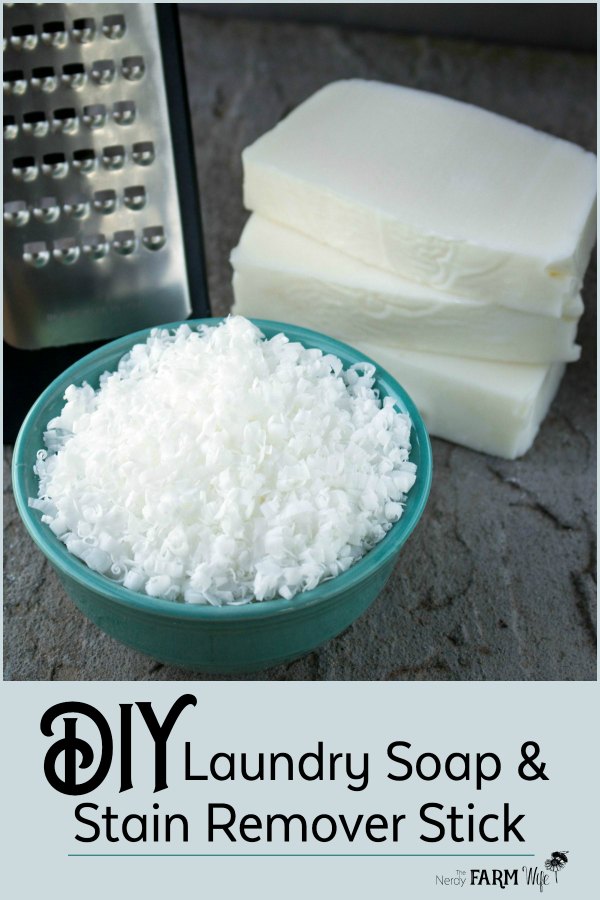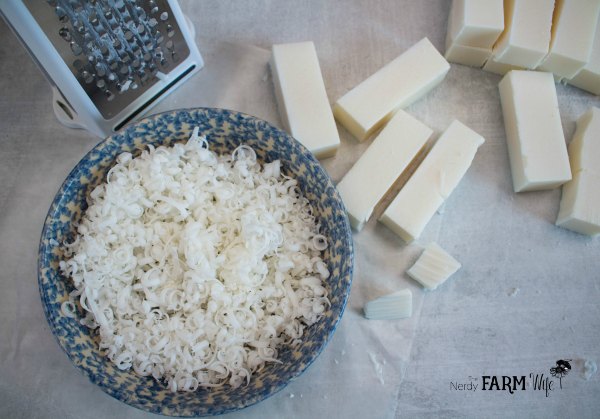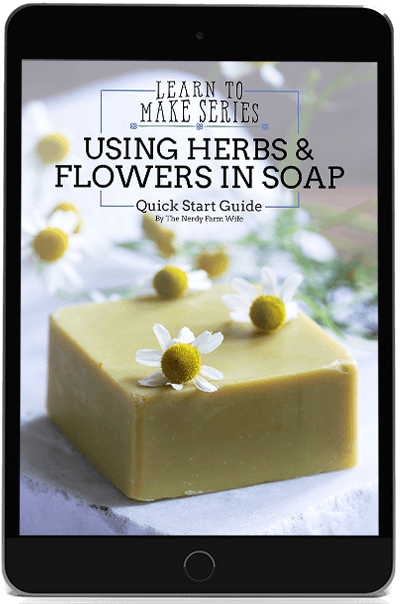Coconut Laundry Soap & Stain Sticks {+ laundry detergent recipe}
Learn to make a homemade laundry soap and stain sticks using just three ingredients. Also included is my easy recipe for laundry detergent!

Unlike my other natural soap recipes, this one is intended for laundry purposes only. It has no extra oils or fats in it, making it better suited for cleaning tough stains on clothes rather than using on your skin.
You can turn it into homemade laundry detergent, and/or cut it into stain sticks. I detail both methods below.
I usually leave the recipe unscented, but you could add 18 to 20 g (about 2 tablespoons) of lavender, peppermint, lemongrass, or your favorite essential oil blend to the recipe, stirring it in at trace.
Video of Making Laundry Soap & Detergent:
Here’s a video of me making a batch of laundry soap from scratch, and then turning it into homemade laundry detergent. (Sometimes an ad plays first, but the video will play right after! If you have an adblocker, you won’t see the video player.)

Ingredients for DIY Coconut Laundry Soap
- 10 oz (283 g) distilled water
- 5.15 oz (146 g) sodium hydroxide (lye)
- 28 oz (794 g) coconut oil
- optional: 18 to 20 g (abt 2 TBSP) essential oil, for scent
You’ll also need a loaf style mold. I use Crafter’s Choice Regular Silicone Loaf Mold – 1501, from Amazon.
Brands of lye that I use and recommend include: ComStar & Essential Depot Food Grade Lye – all can be found on Amazon.
Coconut oil can be ordered online, or is usually carried in the oils or baking section of local grocery stores. (Both virgin and refined coconut oil will work.)
Check the bottled water section of local stores for distilled water, or you could also use deionized or RO water.
Yield: 8 bars of laundry soap, or 16 stain sticks.
Important Note: Please notice that unlike regular soap recipes that require 24 hours in the mold, coconut laundry soap should be removed from the mold and sliced into bars as soon as it’s hard enough to do so. Waiting even 24 hours will likely make your soap too hard to cut into bars. Since the lye could still be active after just a few hours in the mold, be sure to wear your gloves while cutting.
Directions to Make the Laundry Soap
This is an abbreviated overview. Please see my more in-depth article, Soapmaking 101, if you’ve never made soap before.
- Place the water in a heatproof container.
- Put on your gloves and goggles.
- Pour the lye into the water and stir well.
- Avoid breathing in the temporary strong fumes.
- Set the mixture aside to cool for 30 to 40 minutes, or until around 100 to 110°F (38 to 43°C).
- While the lye cools, warm the coconut oil to around 90 to 100°F (32 to 38°C).
- Pour the lye solution into the warm coconut oil and stir by hand briefly.
- Use the immersion blender sparingly, to bring the soap to trace.
- Pour soap into loaf mold.
- Check in 2 to 3 hours. If firm enough, slice into bars, while wearing your gloves.
- Set the bars on sheets of wax paper.
- If grating for laundry detergent purposes, do so before the soap turns too hard. (Anywhere from 2 hours to a couple of days.)
- If making stain sticks, cut into stick shapes, then cure about 2 weeks before using.
Directions to Make & Use the Stain Remover Stick
After slicing the soap into bars, slice each bar again into halves, to create easy-to-hold stick-shaped pieces. Let cure for around 2 weeks.
Wet the soiled garment with plain water and rub the soap directly on it until a lather forms. Launder as usual. These stain sticks should work on most machine-washable clothing, but always do a spot test first to be certain.

Directions to Make Homemade Laundry Detergent
I keep my laundry recipe really simple. It’s worked great for my family for many years!
Please note that I have hard well water and wash most of my laundry with warm water in a top load washer. I know several people who use this for their HE machines with no problem.
Your mileage may vary.
In the past, I could buy super washing soda locally, but that’s no longer the case. Instead, I now buy it from Amazon.
Ingredients:
- 1 1/2 cups grated coconut laundry soap (abt 1 bar, or 2 sticks, from the recipe above)
- 1 1/2 cups super washing soda
- optional: 1/2 to 1 teaspoon essential oils, such as lavender, lemon, peppermint, etc.
Add the grated soap and super washing soda to a food processor. Pulse the mixture until it’s completely mixed, with no visible flakes of soap remaining. Stir in the essential oil, if using.
If the soap is very fresh and still warm, spread the mixture out in a shallow dish or pan to cool before storing in a jar or container.
The amounts given in the recipe above yield roughly 2 1/2 cups washing powder.
Use 2 to 3 tablespoons per load of laundry.



Can you make laundry soap/detergent with other oils? I once used coconut oil on my face and it broke out as a result I don’t even want to try mixing it with anything else to use as a moisturiser. And because of the breakout I’m thinking perhaps it would irritate my skin after washing clothes with the coconut oil detergent – I don’t want to make a whole batch to try it out.
Anne
Hi Anne! That’s a great question! I’ve seen some tallow laundry soaps before, but coconut oil still might be a great option for you! Coconut oil applied directly on your face, is going to be a lot different than coconut oil that’s transformed by lye and turned to soap. It shouldn’t have any residue that would linger on your clothes so shouldn’t cause a breakout any more than any other detergent would. I hope that helps! :)
Hello Jan, first of all, thank you so much for share with us your amazing recipes and tips, It helps a lot…. Sorry about my ignorance, does washing soda is the same as baking soda? can we youse baking soda al laundry soap instead of washing soda? Thanks, Send you regards from Mexico.
Hi Aide! That’s a great question! I had always wondered that myself before. It’s a little different, but you can make your own washing soda from baking soda.
https://www.mommypotamus.com/how-to-make-washing-soda/
Love your books – Just thought I would add a tip. I find it easier to peel the soap rather than grate it. Peeling works even better when the bar is really hard as it make the soap into a fine powder. I used to keep my soap in the hot water cupboard to harden for that very purpose.
Hi Llyvonne! Thanks for the awesome tip! I’m definitely going to try that out! Thank you! :)
Hi Jan, thank you very much for the recipe. That’s very nice of you. I was just wondering if you do a water discount or do you keep it at 38% and do you do a superfat? Have you heard of adding some Borax to the recipe, or is only coconut oil great for removing stains? Thank you so much.
Maureen
Hi Maureen! Yes, I do some water discount with almost all of my soaps and for this one, it works out to about 36%. (However, to calculate the water amount in this case, I just used a rounded amount of twice as much water as lye.) The superfat for this one is at 0% since you don’t want any extra oils on your laundry. I’ve also heard of some recipes that include Borax & I definitely want to try that out some time, but I haven’t yet. I’ve always had good results with this combination, so have been a little lazy on trying something new. :)
Hi Jan! First of all, I really enjoy following your blog – interesting to note, that when I’m reading or doing research, I always seem to end up on your pages (insert heart here) without as a favourite go-to, without even realizing it :) I’ve been searching for a stain stick that also utilizes beeswax. Have you tried this as an additive yet, or come across an article? Thanks so much!
Hi Stephanie, Thanks for the kind words about the blog! :) I haven’t seen a stain stick recipe with beeswax yet; will have to keep my eyes out & see if I spot anyone trying that. It sounds interesting!
Hi Jan!
I’m doing my research on soapmaking and your blog has been super helpful. I understand the process much better now! Thank you!
I’m wondering if potassium hydroxide can be used in this recipe to make it a liquid soap to begin with, rather than hydrating soap made with sodium hydroxide?
Hi Sarah Jane, Yes, you sure can make a 100% coconut oil liquid soap! However, it can be really thin, so there’s a few things to consider before making.
The Soapmaking Forum has a few threads on that topic that should be helpful! :)
https://www.google.com/search?q=soapmakingforum.com+coconut+oil+liquid+soap
Hi I have a couple of questions : )
When making the laundry detergent do you add the essential oil twice? To the laundry soap, and when using the laundry soap to make the detergent or do you just add it at one or other stage?
Also can you use the detergent straight away or does it need to be stored for a length of time first as the soap is not cured?
Thanks : )
Hi Sophie! Most of the essential oil scent gets lost during the soapmaking process, so for strongest scent, you could just add it to the DIY detergent mixture.
You can use the detergent right away. Laundry soap doesn’t have to be cured. :)
Hi, is it ok to use cheap fully hardened cocnot oil for this soap as it’s anyway for cleaning/washing?
Hi Florina! You want to use the type of coconut oil that gets hard when it’s cold, but melts when it’s over 76 degrees F (24.4 degrees C).
It doesn’t matter if it’s an expensive brand or a cheap brand – as long as it’s pure coconut oil, it will work the same way in soap. :)
Hi! This is my second time trying this recipe and I love it! It works so well.
Each time I make it, it cracks up the middle after i pour it in the mold. What am I doing wrong? Pouring too hot? Not insulating enough?
Hi Laura! It does sound like your soap might be getting a little hot – you probably don’t have to insulate it at all.
You could also try pouring into a shallower mold so that it cools faster.
The good thing is that it’s still completely fine to use for laundry, whether it cracks in the middle or not! :)
Hi. Would you be able to use this as a base for liquid dish soap?
Hi Nicole! Liquid soaps have a different structure and lye needed, so I would just make a batch of liquid soap, specifically for washing dishes – so probably one with no superfat, and no added fragrances.
Here’s my tutorial on making your own liquid soaps, which you could use as a starting point for your recipe: :)
https://thenerdyfarmwife.com/liquid-soap-from-scratch/
Thank you so much for this recipe! I just finished making my second batch. I use it for both laundry & dishes! It is the MOST FANTASTIC cleaner! My clothes are so much cleaner than when I was (mistakenly) using ivory bar soap, and my hands don’t break out while folding clothes like it did when I used Fels Naptha. So I am TRULY grateful to you for writing up this recipe! Dishes are clean even when I only have cold water! This is truly an awesome soap. My hands are softer & never red like they used to be!
FYI washing soda is the same thing as soda ash which you can easily get at a pool supply place (sometimes lowes/home depot) & I believe it’s cheaper that way. I also use borax in my recipe. 1 c ground bar soap (from this recipe) 1 c borax & 1 c washing soda. I use about 1/4 c per load, but I have a huge speed queen washer.
Thanks for a great site! I have made your recipe for the Honey & Oatmeal soap as well. It is equally wonderful! I’m so glad I found your site!
Hooray! I’m so glad to hear the laundry soap is working well. Thanks for sharing your recipe & tips with us! :)
Hi Jan
I am new to soap making. My first soap was your cold pressed Aloe Vera soap. Loved it! I have learned so much from you, thank you
Today I made the Coconut Laundry soap. I done something wrong. It is separating in the loaf mould. A clear liquid is forming onto of the solid white soap. Any idea where I went wrong?
Thank you, Bianca
Hi Bianca, So sorry to hear about the soap separating! My first thought is that you may have had a false trace.
That’s where the soap looks like it has reached trace, but it actually only thickened up because the solid fats in the soap got cold too fast.
For that, you’d want to make your soap at higher temperatures, that any solid fats in the recipe are completely melted and hot, and that you’re not working in a freezing cold room that will chill the batter too fast.
Another culprit could be if you added any scent to the soap. Some fragrance oils can be fussy to use and can make soap separate.
Most essential oils won’t do this, but some sketchy brands (especially on Amazon) are actually fragrance oils that have been labeled as an essential oil, and they can be a real problem in soap.
Those are my top two suspects of what may have gone wrong, but you might find more ideas in my troubleshooting soap article:
https://thenerdyfarmwife.com/troubleshooting-cold-process-soap-problems/
Can this be made into a liquid laundry soap? My cold water is way to cold for most powder laundry soap commercial or homemade especially in the winter as our pipes run through the attic
Hi De! I haven’t tried that with this recipe before, so I’m not 100% sure how it would work.
I suspect it should work out in a liquid soap recipe though. Maybe try a mini test batch to see, or perhaps someone will see this comment and chime in letting us know if they’ve tried that or not. :)
I just made my first batch of coconut laundry soap and it has a huge crack. It’s fine because I’m going to grate it, but how do I avoid this in the future?
Hi Deidra! A cracked top can naturally happen sometimes with this recipe.
Cracks usually happen when the soap gets too hot in the mold. You can set your uncovered mold in a cool spot, on a cooling rack if possible, to help keep it from overheating.